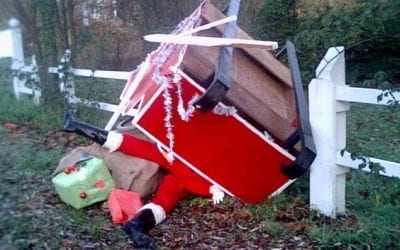Recent high levels of tools theft have resulted in a substantial increase in insurance claims. We’re urging all tradies to take extra precautions when on site and to ensure your tools are securely locked away, ideally out of sight from the road at night.
What’s happening out there?
In Wellington, police are warning contractors and tradesmen to secure valuable tools and equipment after an increase in thefts targeting construction sites and work vehicles across the region. In the Wellington region there have been 96 reported cases of vehicles been broken into since 1 April 2016. The majority have involved ‘trade professional’ type vehicles such as utes, 4×4, and small-medium sized vans. Between 1 May and 15 July 2016 there have also been 49 reported cases of burglary where mainly tools have been stolen from both homes and commercial building sites.
In Auckland, police arrested a “prolific property crime offender” after carrying out a search and seized a large amount of suspicious property including several thousands dollars worth of electronics and trade and electrical tools. Builtin has also heard from Auckland builders who have had tools stolen from the back of their ute, by people just walking past, even though they have only stepped away for a few minutes to ferry materials and other equipment into the property.
As well as in tools being stolen from vehicles and sheds, police say they have seen a rise in vehicle theft. There is no particular trend in the types of vehicles being stolen but many tradesman vans are being targeted.
Police are urging builders, project managers and contractors to be vigilant and take steps to reduce the opportunity for offenders to target construction sites. Security around construction sites is essential. Fencing acts as a deterrent but good locks are important too. The police’s advice to any company with valuable tools and equipment is to make sure they are not left in unattended vehicles that aren’t kept in secure premises overnight and at weekends. This same crime prevention principle extends to construction sites where owners and contractors are encouraged to assess the risks of leaving valuable equipment and tools at vulnerable sites. At a minimum, make sure keys are removed and vehicles locked.
Where possible vehicles that contain tools should be garaged or parked off the roadside and alarmed. If you have a container on site where you store tools this should be fitted with a heavy duty lockbox-style steel cover to prevent the padlock being cut. Portable alarms are also recommended for on site storage containers.
Police recommend people record serial numbers of tools or engrave them, which makes it easier to recover them under search warrants or at second-hand dealers, and to prosecute offenders.
Keep your asset register up to date
To make a claim under a tools & equipment (also known as mobile assets) policy you need to prove your loss. Make sure your tools/asset register includes:
- Item description, including model number
- Serial number
- Date of purchase
- Purchase price
It would also be ideal to keep invoices and photos of all items.
Only your tools & equipment are covered
This means tools owned by the insured entity (eg. the company). It does not cover tools owned by subcontractors on a site, they should insure their own. Employees may have cover under their own contents insurance in some cases and also under the terms of some employment contracts. If you employ staff and contractors make sure they understand this. If you are an employee, check your contract and/or contents policy to find out.
Indemnity/market value vs replacement value cover
Indemnity or market value polices will only pay what the tool is worth when the claim is made. Whilst the premium can be cheaper, it means that for a 5 year old item you’ll only receive what the insurer considers it to be worth at the time of loss.
On the other hand, replacement value cover will replace any item (that can’t be repaired) for new, irrespective of its age or condition. The sum insured must be the replacement value of your tools. Beware, as some policies that claim to be for replacement value will revert to market value on items more than a few years old, so check the fine print.
Theft in the open air vs forced entry (burglary)
Tools and mobile assets policies make a distinction between theft and burglary. Theft is generally considered to be when an item is stolen “in the open air”, that is without any sign of forced entry. So, it would be considered theft if tools were stolen from an unlocked van, but burglary if locked doors were forced to gain entry. The same applies to tools stolen from site or other types of storage. Some policies may include burglary but not theft in the open air.
Even if your policy does include theft in the open air, theft excesses can differ. It’s common to see a $1,000 excess for burglary but $2,500 for theft. You can find policies with options for lower burglary excesses and specialist insurers may also offer a $1,000 excess for theft.
In a nutshell
Having your tools stolen can be a massive inconvenience, cause delays and cost money. Taking preventative measures, keeping good records and having the right insurance cover will ensure that if something does happen you can be back to work quickly and not be out of pocket.




